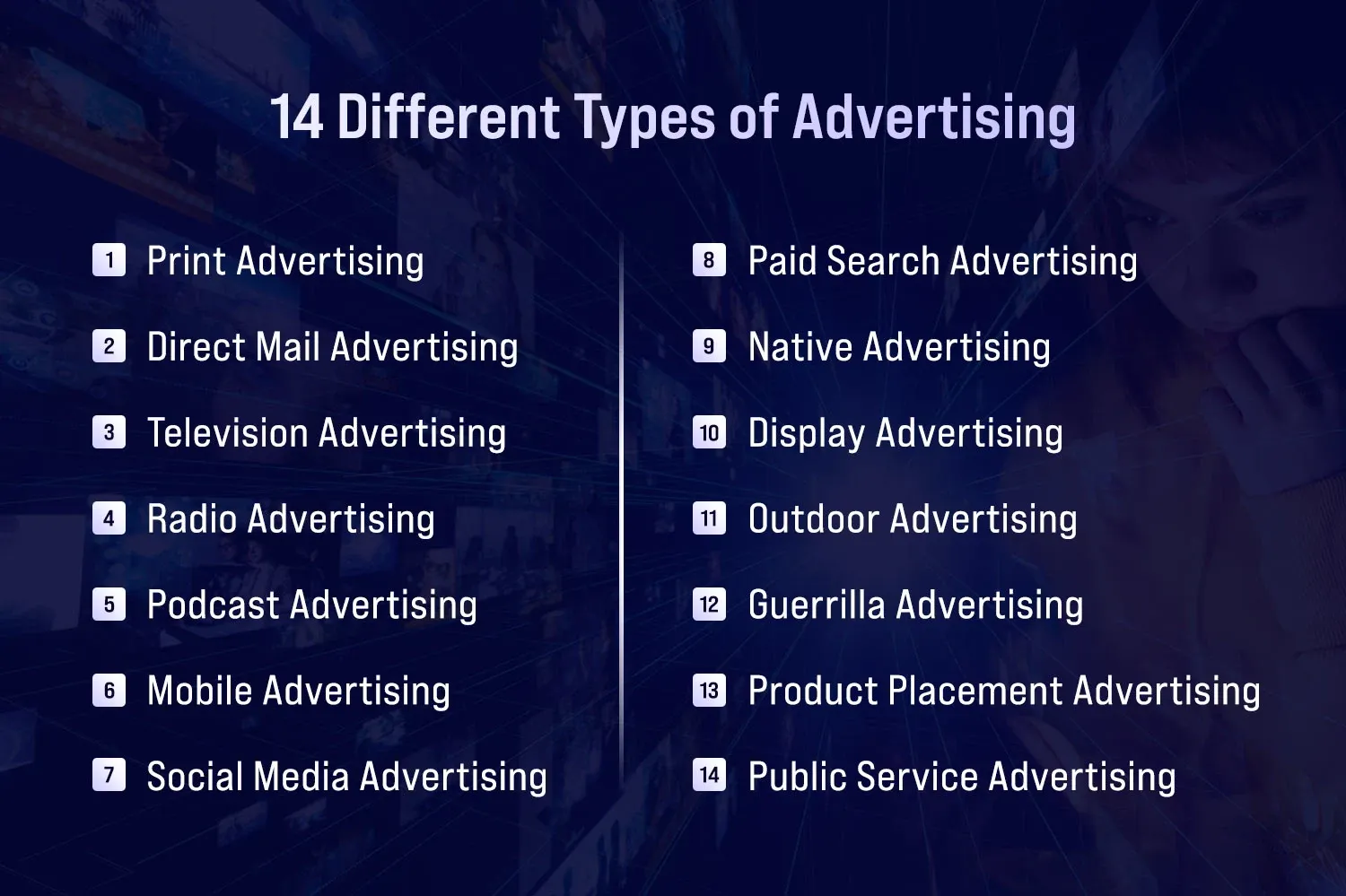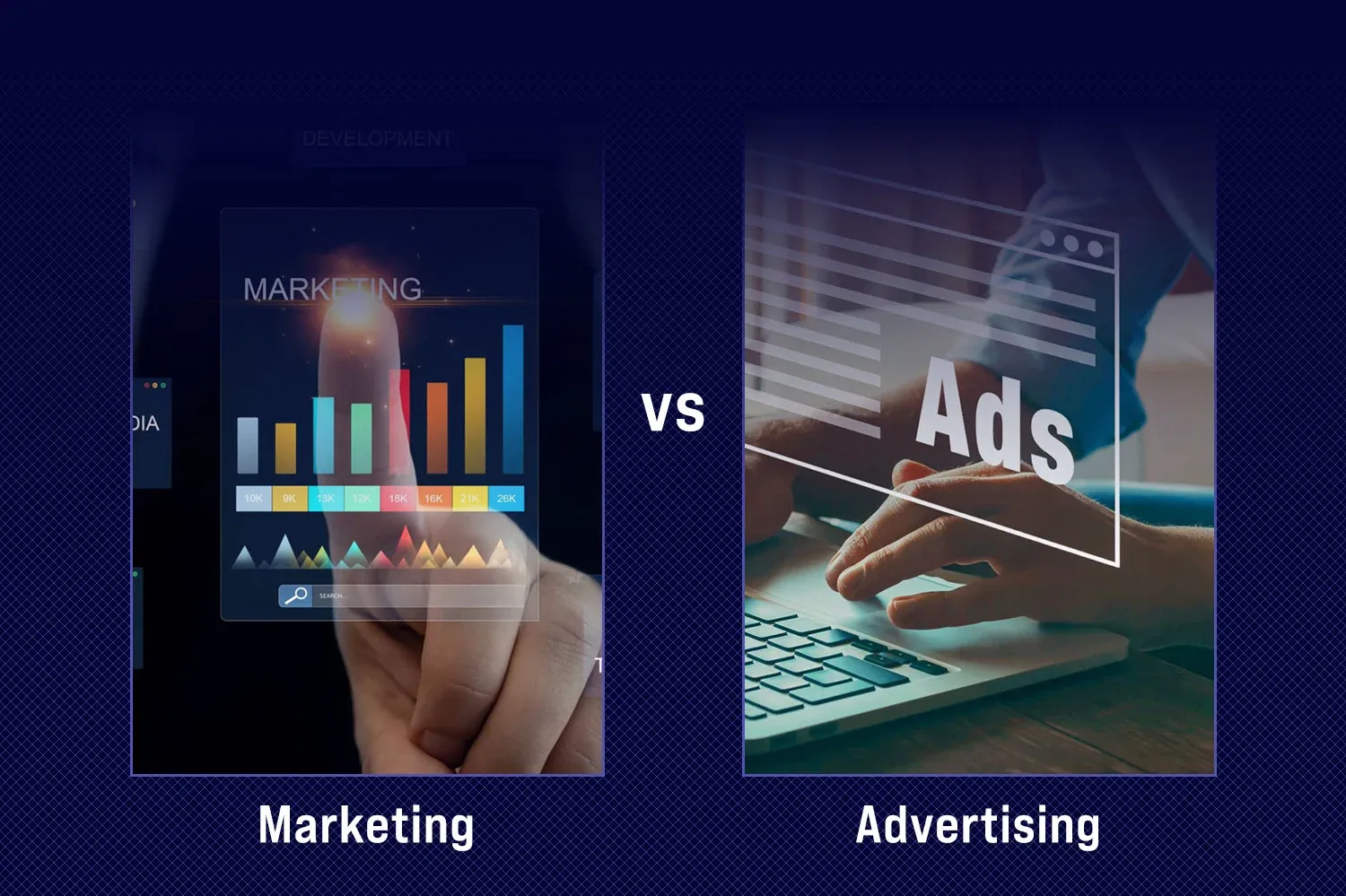Types of Advertising and How to Use Them Effectively?

Advertising has now become more than billboards and TV commercials; it is seen in the insidious placement of a product in your favorite streaming show, or in the algorithmic ads that appear in your social feeds. All businesses, including startups and large companies, are familiar with the strategic benefits of various advertising platforms and how to use them to maximize return on investment (ROI).
This in-depth article examines 14 advertising strategies that today’s businesses use to attract attention, foster engagement, and turn potential customers into brand advocates.
What is Advertising?
Advertising is a strategic promotional method used by companies to market their products, services, or ideas to specific audiences. It plays a vital role in marketing by grabbing attention, sparking interest, and motivating consumers to act—whether that’s making a purchase or interacting with a brand.
More precisely, advertisements are media messages that are created to market products. They are presented in various forms, both in the form of static print materials and television advertisements, and dynamic digital banners and interactive videos. With the development of technology, advertising no longer exists solely in conventional media; nowadays, it also appears on digital platforms, social media, mobile apps, and so on.
Ads can play an essential role in modern marketing since they provide an efficient and quantifiable means to attract and impact potential customers. It is an effective way to increase revenues, brand awareness, and develop stronger customer relationships when done strategically. Furthermore, they are goal-oriented and have KPIs that enable businesses to measure ROI and tailor messages based on reactions.
14 Different Types of Advertising
Depending on the target audience, budget, and marketing goal, businesses today have the freedom to choose from a variety of advertising tactics. Below, we explore 14 different types of advertising media that companies most use to capture attention, build brand awareness, and drive sales.

1) Print Advertising
Print advertising refers to promotional content published in print media such as newspapers, magazines, brochures, and journals. It's most effective for medium to large organizations aiming to reach specific audiences based on reading habits and publication type.
Print ads can generate substantial visibility and brand awareness with an effective visual design, a clear message, and proper positioning in the right publication. Although more expensive and particularly premium, print advertising, when done properly, provides a tangible, trusted channel for reaching targeted demographics and prompting action with attractive visual images and calls to action (CTAs).
2) Direct Mail Advertising
Direct mail advertising is a selective method of advertising in which a business organization directs physical promotion to the mailboxes of potential customers, such as brochures, postcards, or letters. The characteristic of this approach is its ability to tailor the message, target a specific geographic or demographic group, and deliver a tangible, memorable brand experience.
With trackable performance metrics and strong ROI potential, direct mail offers a strategic, measurable way to boost engagement and drive conversions, especially when integrated with broader marketing campaigns.
3) Television Advertising
Television advertising is an effective marketing tool in which advertising messages are conveyed through television programs, using visuals, sounds, and narrative to reach wide and varied audiences. It has exceptional reach and emotional power, allowing brands to produce memorable, high-quality campaigns that connect with millions of people simultaneously.
Even with the rise of digital, TV ads remain useful for their credibility, immersive experience for viewers, and the ability to target specific audiences using data and addressable TV technology.
4) Radio Advertising
Radio advertising: Radio advertising is an advertising method that uses audio to promote products or services, delivered via AM (Amplitude Modulation), FM (Frequency Modulation), or digital radio. It’s a cost-effective way to reach targeted listener demographics using creative voiceovers, music, and sound effects to capture attention and reinforce brand messages.
With the ability to tailor campaigns locally or nationally and adapt quickly to market changes, radio advertising offers wide reach, strong frequency, and a personal connection that drives engagement and action.
5) Podcast Advertising
Podcast advertising is a highly targeted audio marketing strategy in which short ads, typically 15 to 60 seconds, are embedded at the beginning, middle, or end of podcast episodes. It allows brands to connect with engaged, often niche audiences in an intimate, trusted environment.
With flexible pricing based on reach and impressions and the option for host-read or pre-produced ads, podcast advertising delivers high recall and strong purchase intent—54% of listeners are more likely to buy from brands they hear about on podcasts—making it a smart, ROI-focused choice for advertisers.
6) Mobile Advertising
Mobile advertising is a multichannel strategy that delivers real-time promotional content to users on smartphones, tablets, and other mobile devices. As consumers increasingly use mobile for shopping, streaming, gaming, and more, brands use mobile ads to meet audiences where they are.
This approach enables marketers to promote products, deals, and launches through targeted, on-the-go engagement—making mobile advertising essential for creating seamless, omnichannel customer experiences and maximizing reach in the digital age.
7) Social Media Advertising
Social media advertising is a form of digital marketing in which companies pay to have their ads placed on social networking sites like Facebook, Instagram, Twitter, and LinkedIn to reach specific target groups. Using the advanced targeting features of these platforms, brands can advertise products, drive sales, and raise brand awareness by reaching the right customers based on factors such as location, interests, and behaviors.
Social media ads are highly impactful, enabling businesses to engage users throughout their purchase journey—from creating buzz for new products to remarketing for high-ticket sales.
8) Paid Search Advertising
Paid search advertising is an online marketing tactic where companies pay to feature their ads at the top of search engine results, primarily on Google. These ads, often marked with "Ad," appear when users search for keywords relevant to the business.
The dominant pricing approach is pay-per-click (PPC), in which businesses incur costs only when a potential customer interacts with their advertisement. Paid search advertising allows businesses to target highly relevant searches, making it an effective strategy for driving traffic and increasing conversions when managed properly.
9) Native Advertising
Native advertising is a paid promotional method in which ads naturally integrate into a platform’s content. In contrast to traditional banner ads, native ads blend into the platform's design, structure, and functionality, providing a natural user experience.
Such advertisements might be presented in the form of sponsored content, or recommended articles on websites, in-feed ads on social media, or promoted entries in search engines. Native ads do not interfere with user interaction; therefore, they are an effective way to deliver promotional content in a natural manner.
10) Display Advertising
Display advertising is a digital marketing tool that is visually oriented and is used to advertise a brand on websites and social media platforms by using images, text, GIFs, or videos. Such advertisements are often placed in specific areas, e.g., banners, designed to attract attention and raise brand awareness.
Display advertising also allows marketers to reach people based on their demographics, behaviours, and interests, enabling them to deliver ads accurately. It is an effective way of engaging the users and increasing brand awareness through both creative imagery and strategic positioning.
11) Outdoor Advertising
Outdoor advertising, or OOH (out-of-home) advertising, refers to promotional media displayed outdoors, such as billboards, bus-shelter ads, transit ads, and neon signboards. It aims to reach consumers when they are away from home, typically in high-traffic areas such as highways or near businesses and institutions.
Outdoor advertising can help build brand awareness, increase visibility, and drive local sales. The success of an outdoor campaign relies on factors such as location, ad design, and timing, ensuring the appropriate message is delivered to the right audience at the right time.
12) Guerrilla Advertising
Guerrilla advertising is a new form of marketing approach that is based on aggressive, unorthodox methods to shock and attract the attention of people. It interrupts public spaces or occasions with unforgettable, often excessive imagery or actions to create buzz and brand recognition.
In contrast to conventional advertising, guerrilla marketing thrives on creativity, one-on-one connections, and word of mouth, making it effective in urban areas with very small budgets. When well implemented, it may result in major brand recognition and interaction, particularly when enhanced by social media.
13) Product Placement Advertising
Product placement advertising is a marketing strategy in which brands or products are incorporated into entertainment programs, such as movies, television shows, and video games, to market them in a non-obtrusive manner. In contrast to conventional advertising, product placement places the product in the context of the story, allowing the consumer to see the brand without disrupting his or her experience.
Moreover, this approach tends to be more cost-effective than traditional advertising and allows targeting the audience in a natural, less invasive way. Product placement also boosts brand recognition and can offer international exposure via global media.
14) Public Service Advertising
Public Service Advertising (PSA) is a type of advertisement aimed at spreading social causes and influencing the population to change their behavior positively. Such advertisements are usually created in partnership with non-profit organizations, governments, or other agencies, and are published at no cost by media houses.
PSAs aim to raise awareness of issues of interest to society, change attitudes, and encourage healthy behaviors. Such campaigns usually aim to address social issues such as public health, safety, the environment, and social justice, benefiting society as a whole.
Marketing vs. Advertising

The following is a detailed list of the major distinctions between marketing and advertising:
Aspect | Marketing | Advertising |
Responsibilities | Marketing is responsible for developing a comprehensive strategy, conducting market research, tracking audience engagement, and measuring the overall effectiveness of campaigns. It involves brand development, customer relationship management, and cross-department alignment. | Advertising focuses on creating and executing campaigns designed to deliver specific messages via chosen media platforms. This includes media buying, creative production, and campaign management. |
Purpose | Marketing uses a wide range of techniques like market research, inbound marketing, content marketing, SEO, and customer segmentation to create a holistic and sustainable brand presence. | Advertising relies on ad creative, media buying, digital advertising, and traditional methods like TV, radio, and print ads to engage the audience quickly and generate immediate responses. |
Required Investment | Marketing requires investment in technology (e.g., marketing automation), human resources (e.g., product managers, content creators), and tools (e.g., customer relationship management systems, data analytics). | Advertising investments are primarily focused on ad spending, media buying costs, creative production, and fees for agencies or freelance experts responsible for campaign execution. |
Success Measurements | Marketing success is measured using metrics like customer lifetime value, market share, engagement rates, customer retention, and brand perception. These focus on long-term results. | Advertising success is evaluated using key performance indicators (KPIs) like Return on Ad Spend (ROAS), click-through rates (CTR), impressions, and conversion rates, with an emphasis on short-term results. |
Generating Results | Marketing produces long-term results that develop gradually over time, building up brand awareness, customer trust, and loyalty, ultimately leading to sustained growth. | Advertising yields immediate, short-term results that can generate quick conversions, but the impact tends to diminish without sustained advertising efforts. |
FAQs
Q1. What are the 7 methods of advertising?
Ans: The seven core advertising channels consist of:
- Print Advertising: Advertisements issued via newspapers, periodicals, and information pamphlets.
- Broadcast Advertising: Television advertising and radio advertising.
- Outdoor Advertising: Visual elements such as billboards, bus and train placements, and key posters in high-traffic areas.
- Digital Advertising: Social media and search engine advertising.
- Direct Mail Advertising: Real mail, such as catalogs and postcards.
- Placing Advertisements: The planned placement of products in movies, TV shows, or other media.
- Guerrilla Marketing: Surprising and noticeable advertising in the streets.
Q2. What are the 5 types of online advertising?
Ans: The five main categories of online advertising are:
- Display Ads: Graphical advertisements on the Web, such as banners, pop-ups, and sidebars.
- Native Advertising: Advertisement from a third party that looks like platform content, e.g., a sponsored blog post.
- Search Engine Marketing (SEM): Paid purchases on search engines such as Google Ads.
- Social Media Advertising: Advertisements in social media networks such as Facebook, Instagram, and Twitter.
- Video Advertising: Pre-roll, mid-roll, and post-roll video advertising on websites such as YouTube.
Summing Up
In the modern competitive digitalized world, advertising has become a dynamic multi-platform strategy that must shift according to the behavior and technology of the consumer. Print and broadcast, digital, mobile, and experiential advertising all offer distinct strengths that businesses can capitalize on depending on their objectives, target audience, and budget size.
Learning to navigate this heterogeneous world of advertising will enable marketing professionals to create more sophisticated, multi-channel approaches that capture the audience's attention and drive measurable results for the business. Regardless of the size of your business or the level of its maturity, a well-coordinated decision and mix of the appropriate advertising techniques is pivotal to increasing the level of brand awareness, enhancing interaction, and improving ROI in a highly dynamic market environment.





